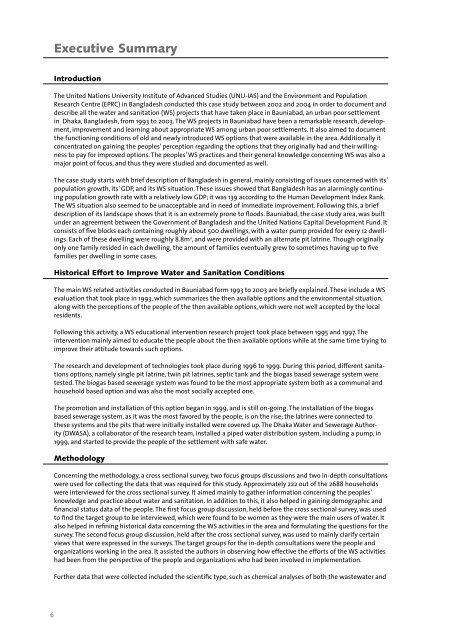Untitled - UNU-IAS - United Nations University
Untitled - UNU-IAS - United Nations University
Untitled - UNU-IAS - United Nations University
Create successful ePaper yourself
Turn your PDF publications into a flip-book with our unique Google optimized e-Paper software.
Executive Summary<br />
Introduction<br />
The <strong>United</strong> <strong>Nations</strong> <strong>University</strong> Institute of Advanced Studies (<strong>UNU</strong>-<strong>IAS</strong>) and the Environment and Population<br />
Research Centre (EPRC) in Bangladesh conducted this case study between 2002 and 2004 in order to document and<br />
describe all the water and sanitation (WS) projects that have taken place in Bauniabad, an urban poor settlement<br />
in Dhaka, Bangladesh, from 1993 to 2003. The WS projects in Bauniabad have been a remarkable research, development,<br />
improvement and learning about appropriate WS among urban poor settlements. It also aimed to document<br />
the functioning conditions of old and newly introduced WS options that were available in the area. Additionally it<br />
concentrated on gaining the peoples’ perception regarding the options that they originally had and their willingness<br />
to pay for improved options. The peoples’ WS practices and their general knowledge concerning WS was also a<br />
major point of focus, and thus they were studied and documented as well.<br />
The case study starts with brief description of Bangladesh in general, mainly consisting of issues concerned with its’<br />
population growth, its’ GDP, and its WS situation. These issues showed that Bangladesh has an alarmingly continuing<br />
population growth rate with a relatively low GDP; it was 139 according to the Human Development Index Rank.<br />
The WS situation also seemed to be unacceptable and in need of immediate improvement. Following this, a brief<br />
description of its landscape shows that it is an extremely prone to floods. Bauniabad, the case study area, was built<br />
under an agreement between the Government of Bangladesh and the <strong>United</strong> <strong>Nations</strong> Capital Development Fund. It<br />
consists of five blocks each containing roughly about 500 dwellings, with a water pump provided for every 12 dwellings.<br />
Each of these dwelling were roughly 8.8m 2 , and were provided with an alternate pit latrine. Though originally<br />
only one family resided in each dwelling, the amount of families eventually grew to sometimes having up to five<br />
families per dwelling in some cases.<br />
Historical Effort to Improve Water and Sanitation Conditions<br />
The main WS related activities conducted in Bauniabad form 1993 to 2003 are briefly explained. These include a WS<br />
evaluation that took place in 1993, which summarizes the then available options and the environmental situation,<br />
along with the perceptions of the people of the then available options, which were not well accepted by the local<br />
residents.<br />
Following this activity, a WS educational intervention research project took place between 1995 and 1997. The<br />
intervention mainly aimed to educate the people about the then available options while at the same time trying to<br />
improve their attitude towards such options.<br />
The research and development of technologies took place during 1996 to 1999. During this period, different sanitations<br />
options, namely single pit latrine, twin pit latrines, septic tank and the biogas based sewerage system were<br />
tested. The biogas based sewerage system was found to be the most appropriate system both as a communal and<br />
household based option and was also the most socially accepted one.<br />
The promotion and installation of this option began in 1999, and is still on-going. The installation of the biogas<br />
based sewerage system, as it was the most favored by the people, is on the rise; the latrines were connected to<br />
these systems and the pits that were initially installed were covered up. The Dhaka Water and Sewerage Authority<br />
(DWASA), a collaborator of the research team, installed a piped water distribution system, including a pump, in<br />
1999, and started to provide the people of the settlement with safe water.<br />
Methodology<br />
Concerning the methodology, a cross sectional survey, two focus groups discussions and two in-depth consultations<br />
were used for collecting the data that was required for this study. Approximately 222 out of the 2688 households<br />
were interviewed for the cross sectional survey. It aimed mainly to gather information concerning the peoples’<br />
knowledge and practice about water and sanitation. In addition to this, it also helped in gaining demographic and<br />
financial status data of the people. The first focus group discussion, held before the cross sectional survey, was used<br />
to find the target group to be interviewed, which were found to be women as they were the main users of water. It<br />
also helped in refining historical data concerning the WS activities in the area and formulating the questions for the<br />
survey. The second focus group discussion, held after the cross sectional survey, was used to mainly clarify certain<br />
views that were expressed in the surveys. The target groups for the in-depth consultations were the people and<br />
organizations working in the area. It assisted the authors in observing how effective the efforts of the WS activities<br />
had been from the perspective of the people and organizations who had been involved in implementation.<br />
Further data that were collected included the scientific type, such as chemical analyses of both the wastewater and<br />
6
















